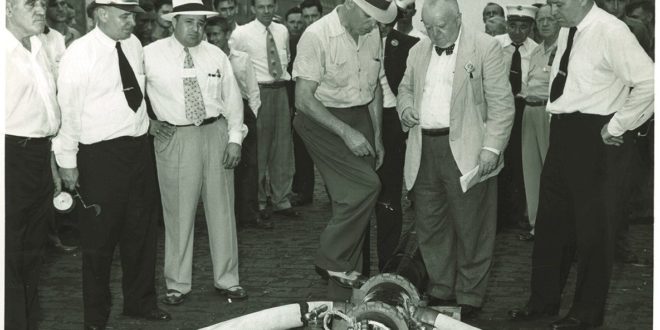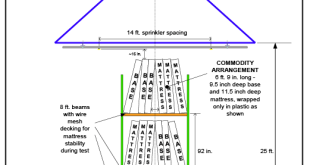
100 Years of Supporting Life Safety Through Innovation
Delivering a Century of Improvements in Productivity and Safety to the Construction Industry
Looking through the lens of history allows a generation of people to consider inventions in another age and appreciate how creative minds have dramatically effected change.
The World War I (WWI) era introduced technologies that transformed the world, ushering in new innovations. In 1918, Lieutenant Ernest Tribe of the British Royal Engineers recognized the value of a better pipe joint. On April 4, 1919, collaborating with Dr. Henry Selby Hele-Shaw, a research engineer, Tribe filed for a patent for a mechanical pipe joining solution coined The Victory Joint and founded The Victory Pipe Joint Co., now known as Victaulic.
Enabling Global Modernization The timing of this invention could not have been better. By the 1920s, the world saw tremendous growth and modernization. Enormous construction programs incorporated this new mechanical joint, which introduced a way to join pipe with bolted grooved couplings using a gasket seal. The technology was used in the construction of ambitious projects like the Hoover Dam and the Panama Canal as well as massive construction projects undertaken by the U.S. government’s Public Works Administration.
The Victaulic coupling helped construct history, and over the next several decades, it helped preserve history, too. The Victaulic coupling enabled the restoration of Independence Hall in Philadelphia, where it was used on the domestic waterlines to eliminate fire hazards. It was also installed in the Alexandria Library in Egypt, which houses eight million books and thousands of precious artifacts.

The success of the original mechanical joint led to variations that were introduced to multiple industries, improving safety and reducing risk through better system designs. As new products were introduced, the company’s goals remained the same, to put people to work faster, maximizing efficiency and ensuring reliability while improving safety.
Leaders at Victaulic had recognized that efficiency and productivity go hand-in-hand with safety long before 1970, when President Richard Nixon signed the Williams-Steiger Occupational Safety and Health Act, federalizing worker safety issues and creating the United States Occupational Safety and Health Administration (OSHA) and the National Institute for Occupational Safety and Health (NIOSH).
Innovation and Fire Safety In 1952, Underwriters’ Laboratories (UL) listed Victaulic’s couplings and fittings for use in fire protection systems. By 1955, Vic-Easy roll grooving tools were providing fire protection companies with portable, light wall steel pipe grooving capabilities for solutions that were more economical and easier to install than traditional alternatives.
The company officially established its Research and Development (R&D) program in 1957, eventually leading to the introduction of more than 100,000 products and more than 2,000 patented designs.
In the 1970s, Victaulic led the way in gaining UL listing and FM approval of a less-than-standard 0.19-in. wall thickness steel pipe for fire protection services, which reduced costs in the industry. The company also introduced the Fast Installation Tee, making it possible to use plain end, light wall, and standard-weight steel pipe on fire protection branch lines that could directly accept sprinkler heads and threaded drops. Continuing through the 1980s, Victaulic rolled out its FireLock™ portfolio, a line of lighter and more compact valves and fittings for use in fire protection systems that features the excellent flow performance Victaulic is known for.
As an industry leader, Victaulic recognized the importance of aligning itself with other construction industry leaders. So, when the American Fire Sprinkler Association (AFSA) was organized in 1981, Victaulic leaders immediately understood the significance of becoming involved in the association. The importance of the organization, then as now, was apparent.
According to Chris Stason, Eastern USA VicFlex™ Manager at Victaulic, the value in membership is that it, “allows Victaulic to be involved within the contracting community and publicly advocate for the sprinkler industry.”
Stason is on the Manufacturers/Supplier (M/S) Council for AFSA and was a member of the committee that wrote a complete Inspection, Testing, & Maintenance course to attract new employees into the industry and in less than two years train them to a minimum of a NICET II rating, enabling them to complete inspections on fire protection systems.
For Larry Sander, Eastern Divisional Fire Protection Sales Manager at Victaulic, the greatest value in belonging to AFSA is the ability to leverage the forum to collaborate on industry issues and the development of solutions.
Conversations and relationships established through AFSA membership help Victaulic better understand industry challenges and design products to meet changing needs. Before the millennium, Victaulic developed its first automatic sprinkler and remains dedicated to sprinkler industry innovation fueled through collaboration. Shortly thereafter, Victaulic pioneered Installation-Ready™ technology in the 2000s with the introduction of the FireLock EZ™ Rigid Coupling, eliminating the need to disassemble couplings before installation.
Next came a focus on innovation in special hazards fire protection and flexible connections. The industry-first Hybrid Fire Extinguishing System, Victaulic Vortex™, launched in 2008 using water and nitrogen to both absorb heat and reduce oxygen to extinguish fires. Victaulic then introduced the VicFlex™ product line, ensuring customers confidence, speed, and performance with an industry-leading bend radius allowing for unprecedented installation ease. Not stopping, Victaulic continues to expand VicFlex™ into a wide range of applications, even combining flexible technology with dry sprinkler technology.
Collaboration with the contracting community led to the development of groundbreaking technology enabling efficient but consistent and reliable installation, such as the FireLock™ Innovative Groove System | IGS™ for small diameter piping, the Style V9 Sprinkler Coupling and the Style 109 Installation-Ready™ One-Bolt Coupling.
From the outset, the focus on R&D has been consistent—to deliver solutions that make installations faster, easier, more cost-effective, and safer—and through participation in AFSA, the company has a direct connection to the industry, listening and innovating more ways to have an impact on fire safety.
Scott Howser, Victaulic Vice President, Fire Protection Sales, and AFSA committee member notes both AFSA’s annual convention and chapter meetings stay true to collaborative sharing of ideas, embracing innovation and a continued focus on training and education.
“Being a partner with AFSA has expanded relationships through a common goal, promoting the use of automatic fire sprinkler system to save lives,” said Howser. “It has motivated us to commit personal time at the highest level of our organization to advance membership participation through committee participation and locally through training.”
ABOUT THE AUTHOR: Scott Howser is the vice president of fire protection sales for Victaulic, headquartered in Easton, Pennsylvania. He graduated from Iowa State University with a business economics degree. Howser is a member and committee member of AFSA and a member of NFPA. He has been in the construction industry for 25 years, 21 with Victaulic Fire Protection including global responsibilities.

 Sprinkler Age A Publication of the American Fire Sprinkler Association
Sprinkler Age A Publication of the American Fire Sprinkler Association



